After deciding to buy an electric vehicle (EV), the next decision is usually which Level 2 charging station to get. You might also hear these charging stations called by their technical name electric vehicle supply equipment (EVSE), as defined in the National Electric Code.
Safety is the most important consideration when selecting a charging station. The primary function of a charging station for EVs is to provide electrical safety for the driver by reducing the risk of electric shock.
What is a charging station?
A standard Level 1 (120-volt) plug-in station and Level 2 (240-volt) hardwired or plug-in home charging station will provide pass-through alternating current (AC) power from the grid and a safety earth ground to the vehicle for charging. The vehicle converts the AC power to direct current (DC) power to recharge the batteries. Even though the actual “battery charger” is on the vehicle, an EVSE “charging station” adds several layers of safety features to protect drivers from potential electrical and fire hazards while connecting, disconnecting, and charging the vehicle. When plugged in, a charging station will tell the vehicle that power is available and at what level. The vehicle then takes over and initiates and takes full control of the power transfer. If an electrical fault occurs, the station will stop the power transfer immediately and de-energize the cable.
Charging is very safe with the right equipment
When shopping for a charging station, you want to look for independently safety certified equipment. The challenge is that not ALL charging stations on the market go through this process.
When a charging station manufacturer develops a new product or makes a minor change to an existing product, it should send samples to a Nationally Recognized Testing Laboratory (NRTL), such as Intertek (ETL mark) or Underwriter’s Laboratory (UL mark). Safety engineers at these labs perform months of extensive safety testing that products must pass before they can be safety certified and made available to the public for sale. Only products with these marks appearing on the manufactured product’s rating plate are safety certified.
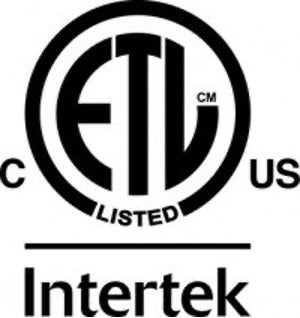
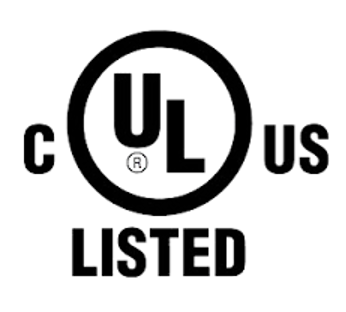
Reputable EVSE manufacturers invest heavily in this third-party safety testing. The laboratory safety engineers test the products against thousands of applicable electrical codes and safety standards.
Intertek and Underwriter’s Laboratory are the most common NRTLs in North America that can test and certify electric vehicle charging stations.
After a product is safety certified, the manufacturer’s factory is then randomly inspected four times a year by the NRTL that did the testing and issued the certification. The NRTL field inspection staff ensures the products being sold are constructed in the same way as the samples that were tested. Changes cannot be made to the products without going back through the certification process.
All this testing, independent validation, and facility inspection must be completed before the NRTL will give the right to apply a safety marking. Only then can the products be sold for drivers to use.
Safety certification is a requirement of the National Electric Code
The National Electric Code (NEC) is the set of standards by which buildings and equipment must be built for the public to use. The NEC requires that all charging stations are NRTL certified to be installed anywhere in the U.S. This is also the case for the Canadian Electric Code (CEC) in Canada. In most places, installing a charging station requires a building permit—the building inspector’s opportunity to verify that the charging station is NRTL listed and that it meets the other required aspects of the NEC. These standards and practices exist to protect public welfare and are commonly enforced for all electrical appliances. Charging stations are high-powered appliances used daily by EV drivers and should be regulated accordingly.
How to tell if a charging station is safety certified
Drivers can look for the official marks from an NRTL (ETL or UL) ON the product itself.
These marks cannot be put on the product unless it has passed the rigorous testing of a certified third-party NRTL and the manufacturer consistently passes the random factory inspections. The NRTL mark must appear ON the product—not on a website or in a manual. The local building inspector will ONLY approve a charging station installation if the certification mark is visible ON the product.
The marks will appear on a certified product’s name plate, also called the rating plate. Here you’ll find the NRTL safety certification markings along with the power and voltage ratings, the manufacturer of origin, part numbers, and warnings. The building inspector will look for this plate to make sure the product has been installed according to its certification. These rating plates are common on all electrical appliances.
If the name plate isn’t on a product and the correct certification marks are not present, do not complete the installation.
Example ClipperCreek name plates:
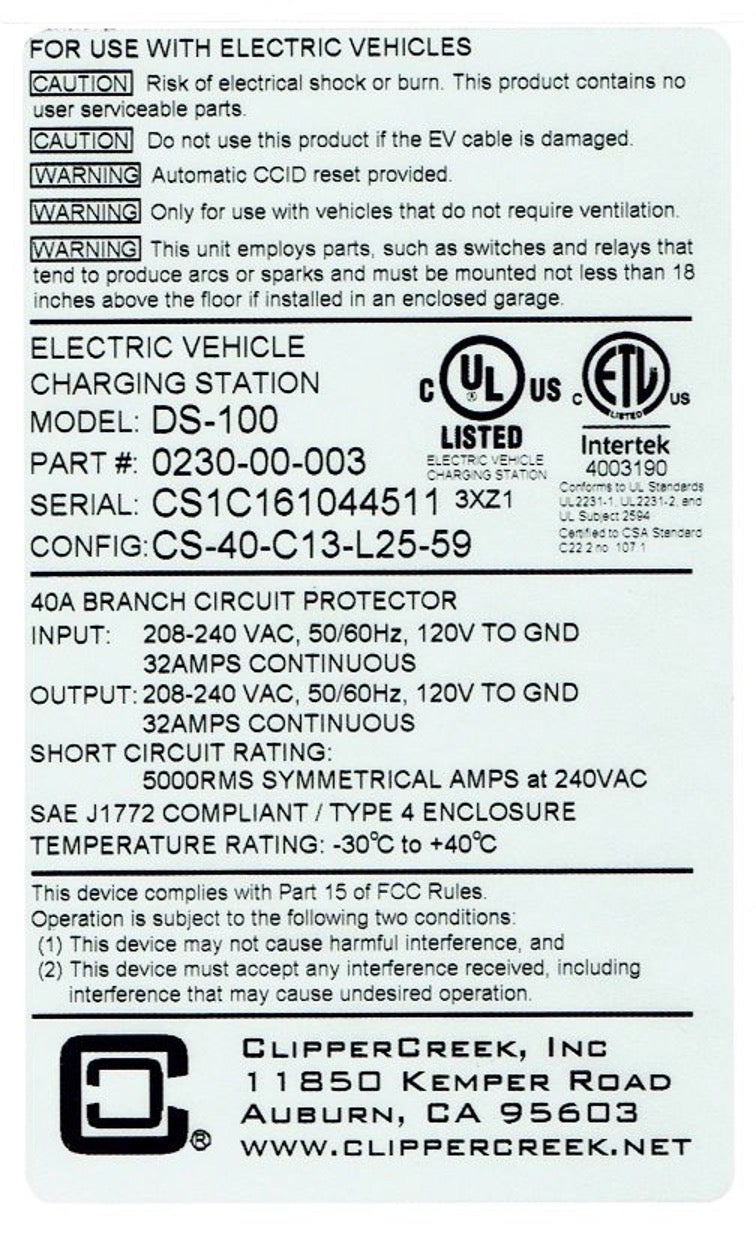
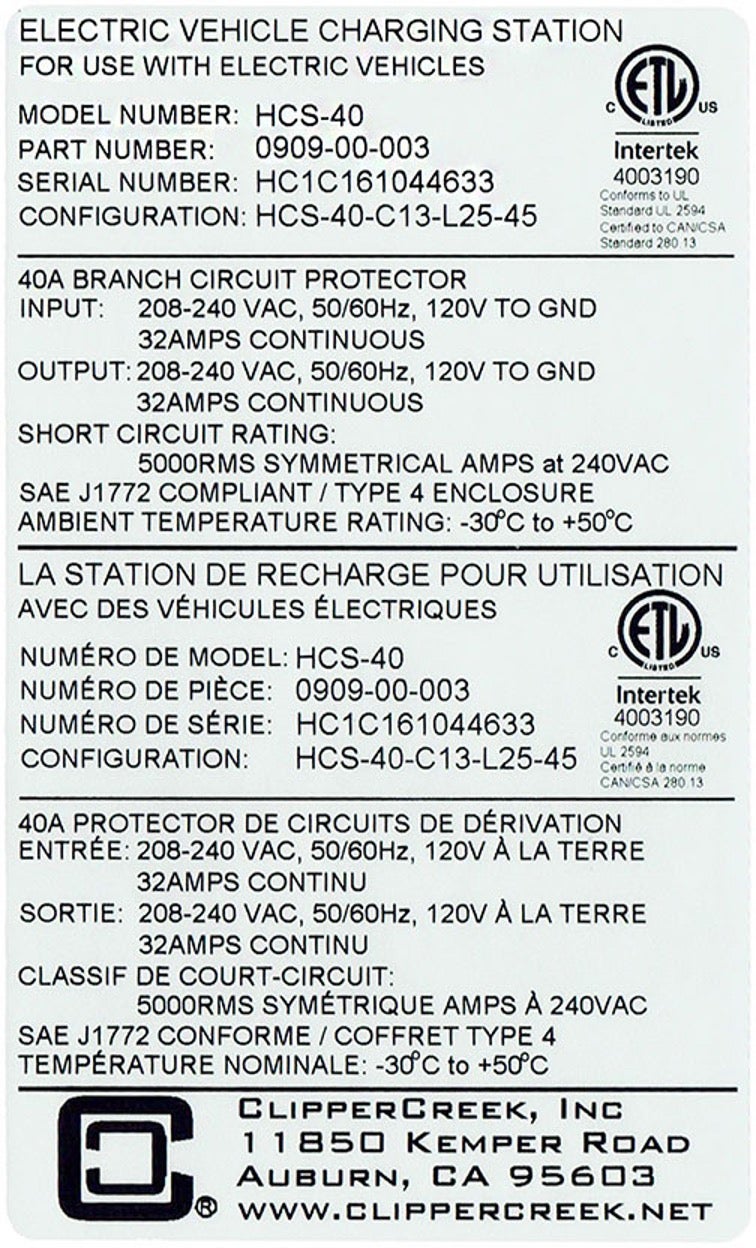
Look out for deceptive markings and claims
Some manufacturers use official-looking marks that are not true NRTL markings. A common mark is a CE logo. If you only see a CE mark, then the product has not been independently certified. CE is a self-certifying mark that the manufacturer can apply on their own; it is not the mark of an NRTL, and it should not be trusted in the US, Canada, and Mexico. A CE mark in addition to the UL or ETL mark is acceptable. The Underwriters Laboratory and Intertek both have online resources that allow the public and the building inspectors to verify authentic or counterfeit markings.

Do NOT use a product that only has a CE mark.
Advertising statements such as “built to UL/ETL/NRTL standards” or “built with UL/ETL/NRTL listed components” should also not be trusted if you see them without the proper markings on the product name plate. Typically, products that have been NRTL certified will indicate this clearly in their advertising materials and specifications with specific terms like “UL/ETL/ NRTL listed” or “Certifications: UL/ETL/NRTL.” When selecting a charging station, if you are unsure about the NRTL certification status of a product, reach out to the product supplier and ask them to provide confirmation of NRTL (UL or ETL) certification. Any charging station manufacturer or supplier should be able to easily refer you to an online directory where you can confirm the up-to-date certification.
Be cautious of companies selling uncertified products
Buying the product from what seems to be a reputable seller doesn’t mean the charging station has been safety certified. Most large home improvement retailer stores like Lowes and Home Depot would likely never carry any electrical item or appliance in their store that was not NRTL certified appropriately. However, there are online retailers, such as Amazon, direct sellers, and sources from outside the United States that do carry and sell uncertified products. It’s usually when shopping on these sites that you need to use these tools and resources to verify the safety of a product.
Do not buy a plug-in charging station with
non-grounded plugs
If you are purchasing a plug-in charging station, never buy a station with a NEMA 10-30 or 10-50 plug.
The NEMA 10-30 and NEMA 10-50 style outlets do not have a safety earth ground connection. There is no way for a charging station with one of these plugs to be NRTL safety certified. One of the key safety functions of a charging station is providing a safety earth ground connection to the vehicle. This assures the vehicle body is safely grounded during charging and prevents the risk of electric shock.
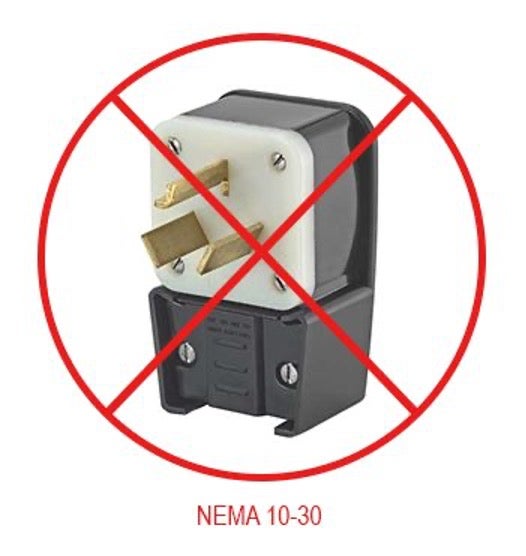

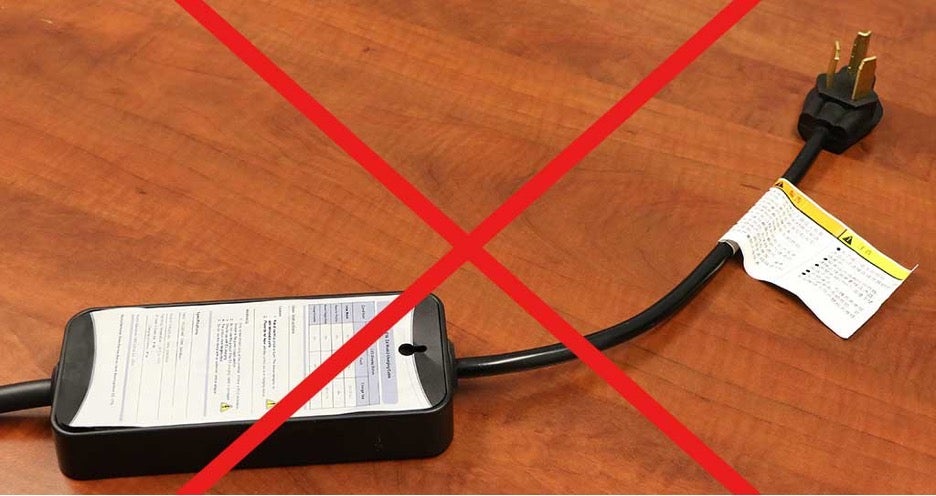
Do not ever use a charging station with a NEMA 10-30 or NEMA 10-50 plug. The station above has a NEMA 10-30 plug. It has no safety ground.
EV charging can be safe and easy
Don’t take chances. Always select a safety certified station. Just as you wouldn’t drive a car that wasn’t crash tested, don’t charge your car with a charging station that hasn’t been tested by an NRTL with an active right to apply the safety markings. Always look for the ETL or UL certification marks.


